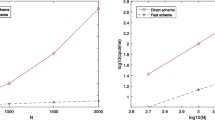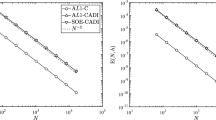Abstract
A singularly perturbed semilinear reaction-diffusion problem in the unit cube, is discretized on arbitrary nonuniform tensor-product meshes. We establish a second-order maximum norm a posteriori error estimate that holds true uniformly in the small diffusion parameter. No mesh aspect ratio condition is imposed. This result is obtained by combining (i) sharp bounds on the Green’s function of the continuous differential operator in the Sobolev W 1,1 and W 2,1 norms and (ii) a special representation of the residual in terms of an arbitrary current mesh and the current computed solution. Numerical results on a priori chosen meshes are presented that support our theoretical estimate.
Similar content being viewed by others
References
Ainsworth, M., Babuška, I.: Reliable and robust a posteriori error estimating for singularly perturbed reaction-diffusion problems. SIAM J. Numer. Anal., 36, 331–353 (1999)
Apel, T.: Anisotropic Finite Elements: Local Estimates and Applications. Teubner, Stuttgart (1999)
Babuška, I., Strouboulis, T.: The Finite Element Method and its Reliability. Clarendon Press, Oxford University Press, New York (2001)
Bakhvalov, N.S.: Towards optimization of methods for solving boundary value problems in the presence of a boundary layer. Zh. Vychisl. Mat. i Mat. Fiz. 9, 841–859 (1969, in Russian)
Boglaev, I.: On monotone iterative methods for a nonlinear singularly perturbed reaction-diffusion problem. J. Comput. Appl. Math. 162, 445–466 (2004)
Castro-Diaz, M.J., Hetch, F.F., Mohammadi, B., Pironneau, O.: Anisotropic unstructed mesh adaptation for flow simulations. Int. J. Numer. Methods Fluids 25, 475–491 (1997)
Chen, L., Sun, P., Xu, J.: Optimal anisotropic simplicial meshes for minimizing interpolation errors in L p -norm. Math. Comput. 76, 179–204 (2007)
Clavero, C., Gracia, J.L., ’Riordan, E.: A parameter robust numerical method for a two dimensional reaction-diffusion problem. Math. Comput. 74, 1743–1758 (2005)
D’Azevedo, E.F.: Optimal triangular mesh generation by coordinate transformation. SIAM J. Sci. Statist. Comput. 12, 755–786 (1991)
D’Azevedo, E.F., Simpson, R.B.: On optimal interpolation triangle incidences. SIAM J. Sci. Statist. Comput. 10, 1063–1075 (1989)
Dolejší, V., Felcman, J.: Anisotropic mesh adaptation for numerical solution of boundary value problems. Numer. Methods Partial Differ. Equ. 20, 576–608 (2004)
Eriksson, K.: An adaptive finite element method with efficient maximum norm error control for elliptic problems. Math. Models Methods Appl. Sci. 4, 313–329 (1994)
Gilbarg, D., Trudinger, N.S.: Elliptic Partial Differential Equations of Second Order. Springer-Verlag, Berlin (1998)
Guzmán, J., Leykekhman, D., Rossmann, J., Schatz, A.H.: Hölder estimates for Green’s functions on convex polyhedral domains and their applications to finite element methods. Numer. Math. 112, 221–243 (2009)
Habashi, W.G., Dompierre, J., Bourgault, Y., Ait-Ali-Yahia, D., Fortin, M., Vallet, M.-G.: Anistopic mesh adaptation: towards user independent, mesh independent and solver independent CFD. Part I: general principles. Int. J. Numer. Methods Fluids 32, 725–744 (2000)
Kopteva, N.: Maximum norm a posteriori error estimates for a one-dimensional convection-diffusion problem. SIAM J. Numer. Anal. 39, 423–441 (2001)
Kopteva, N.: Maximum norm a posteriori error estimates for a one-dimensional singularly perturbed semilinear reaction-diffusion problem. IMA J. Numer. Anal. 27, 576–592 (2007)
Kopteva, N.: Maximum norm error analysis of a 2d singularly perturbed semilinear reaction-diffusion problem. Math. Comput. 76, 631–646 (2007)
Kopteva, N.: Maximum norm a posteriori error estimate for a 2d singularly perturbed reaction-diffusion problem. SIAM J. Numer. Anal. 46, 1602–1618 (2008)
Kopteva, N., Stynes, M.: A robust adaptive method for a quasilinear one-dimensional convection-diffusion problem. SIAM J. Numer. Anal. 39, 1446–1467 (2001)
Kunert, G., Verfürth, R.: Edge residuals dominate a posteriori error estimates for linear finite element methods on anisotropic triangular and tetrahedral meshes. Numer. Math. 86, 283–303 (2000)
Kunert, G.: Robust a posteriori error estimation for a singularly perturbed reaction-diffusion equation on anisotropic tetrahedral meshes. A posteriori error estimation and adaptive computational methods. Adv. Comput. Math. 15, 237–259 (2001)
Ladyzhenskaya, O.A., Ural’tseva, N.N.: Linear and Quasilinear Elliptic Equations. Academic Press, New York (1968)
Linß, T.: Maximum-norm error analysis of a non-monotone FEM for a singularly perturbed reaction-diffusion problem. Nord. Tidskr. Inf. Behandl. 47, 379–391 (2007)
Linß, T., Stynes, M.: The SDFEM on Shishkin meshes for linear convection-diffusion problems. Numer. Math. 87, 457–484 (2001)
Miller, J.J.H., O’Riordan, E., Shishkin, G.I.: Solution of Singularly Perturbed Problems with ε-uniform Numerical Methods—Introduction to the Theory of Linear Problems in One and Two Dimensions, World Scientific, Singapore (1996)
Nochetto, R.H.: Pointwise a posteriori error estimates for elliptic problems on highly graded meshes. Math. Comput. 64, 1–22 (1995)
Polyanin, A.D.: Handbook of Linear Partial Differential Equations for Engineers and Scientists. CRC Press, London (2001)
Remacle, J., Li, X., Shephard, M.S., Flaherty, J.E.: Anisotropic adaptive simulation of transient flows using discountinuous Galerkin methods. Internat. J. Numer. Methods Eng. 62, 899–923 (2005)
Schatz, A.H., Wahlbin, L.B.: On the finite element method for singularly perturbed reaction-diffusion problems in two and one dimensions. Math. Comput. 40, 47–88 (1983)
Author information
Authors and Affiliations
Corresponding author
Additional information
Communicated by Martin Stynes.
This publication has emanated from research conducted with the financial support of Science Foundation Ireland under the Research Frontiers Programme 2008; Grant 08/RFP/MTH1536.
Rights and permissions
About this article
Cite this article
Chadha, N.M., Kopteva, N. Maximum norm a posteriori error estimate for a 3d singularly perturbed semilinear reaction-diffusion problem. Adv Comput Math 35, 33–55 (2011). https://doi.org/10.1007/s10444-010-9163-2
Received:
Accepted:
Published:
Issue Date:
DOI: https://doi.org/10.1007/s10444-010-9163-2
Keywords
- Semilinear reaction-diffusion
- Singular perturbation
- A posteriori error estimate
- Maximum norm
- No mesh aspect ratio condition
- Finite differences
- Layer-adapted mesh




